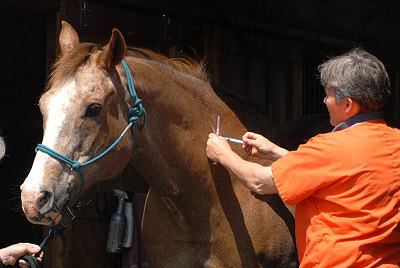Most equestrians give spring and fall shots to our equine counterparts religiously, but few of us take the time to understand what diseases we are safeguarding against. Here we delve into Eastern Equine Encephalomyelitis and why it is considered a “core vaccine” with the American Association of Equine Practitioners (AAEP).
By Sarah E. Coleman

Many of us give “combo” shots, typically four- or five-way combinations of vaccines given in one vial so our horses don’t have to get stuck multiple times with individual needles. These combinations typically include what the AAEP dubs “core vaccines” – those that all horses, no matter their location or occupation, should be vaccinated for to protect their wellbeing.
These core vaccines include:
- Eastern/Western Equine Encephalomyelitis
- Rabies
- Tetanus
- West Nile Virus
Eastern Equine Encephalomyelitis
Eastern Equine Encephalomyelitis (EEE), is one of the core vaccines recommended by the AAEP. EEE was first recorded in the Northern hemisphere in 1831. Similar to West Nile Virus, EEE is transmitted by mosquitoes, so horses that live or spend time near ponds or other still bodies of water have a higher risk of contracting the disease.
Horses (and humans) are a dead-end species for EEE, meaning they cannot pass it on; horses become infected when they are bitten by a mosquito that has picked up EEE from wild birds or rodents, which are “natural reservoirs” for the virus; this means they can carry EEE, but are not affected by it.
EEE causes severe encephalitis in horses; it has a 90 percent mortality rate in horses that are not vaccinated. It is most prevalent in the Atlantic and Gulf Coast states in mid-summer to fall. Evidence suggests that young horses are particularly susceptible to the disease.
Signs of EEE
EEE comes on in a hurry and can be confused with other diseases that affect the central nervous system, like bacterial meningitis, rabies, tetanus, Western Equine Encephalitis, Venezuelan equine encephalitis and West Nile Virus. This disease is also sometimes confused with poisoning. To definitively diagnose a horse, blood must be tested in a lab to see if there are antibodies to the virus present.
Time is of the essence with EEE cases as most affected horses die within three days. An animal that survives may have permanent brain damage.
Signs of EEE include:
- Anorexia
- Fever
- Depression
- Heat tilt
- Impaired vision
- Muscle twitches
- Staggering gait
- Irritability
- Head pressing
- Limb weakness or paralysis
- Coma
- Sensitivity to light
Controlling EEE
EEE tends to appear in “outbreak form,” meaning that the infected horses are generally in close proximity to one another. EEE occurs when horse owners don’t vaccinate their horses or don’t vaccinate so the proper coverage is attained. Horses vaccinated for the first time must receive an injection of EEE followed by a second dose of the vaccine three to four weeks later. This two-dose series is essential to establish an effective immune response. A “booster” is then given in the spring each year thereafter. Veterinarians in some areas may recommend a fall booster, as well.

Vaccination is the No. 1 way to prevent EEE. It is unusual to see EEE in a horse that has been vaccinated for the disease. There is no treatment for EEE; horses are offered only supportive care, including fluids and corticosteroids.
Controlling mosquitos is also key in preventing EEE. This can be done in a number of ways, including:
- Eliminate standing water, including in wheelbarrows, gutters, tarps and other easy-to-forget areas.
- Use larvicidal products that kill mosquito larvae.
- Change drinking water regularly in buckets and troughs.
- Keep horses inside at dawn and dusk, when misquotes are most active.
- Turn on fans to keep mosquitos at bay.
- Encourage predators, including insects that feed on mosquitos and their larvae.
- Apply flyspray and investigate the use of a fly sheet and mask on horses that are outside.
EEE Fast Facts
- In 2016, there were 116 cases reported nationwide to the USDA.
- 24 cases of EEE were in Florida, but cases were reported in every coastal state from Virginia to Texas, as well as in Tennessee and Arkansas.
- Isolated cases in New Jersey and Michigan, plus an outbreak of 19 in Wisconsin, also occurred in 2016.
